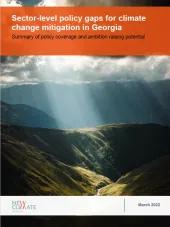This report starts by describing the current situation of the agriculture sector in Georgia, including how the sector is set up, main activities and projections of its development in the future. It gives an overview of the relevant policies related to manure management practices and presents the current and future emissions for the sector. Following that, we present an overview of the different manure management options available globally to then come to a prioritisation of three mitigation measures for manure management emissions in Georgia: the use of covers when storing manure, composting, and manure application as fertiliser, all focused on cattle farms only, given its significant contribution to national manure management emissions.
Other measures were evaluated but finally considered less relevant for Georgia in the short term. These measures could be considered for the medium to long term, but investments and capacity building must start now so the mitigation potential can be realised in the longer term. The two main factors for disregarding the other manure management practices were that most farming is done at a very small scale and that a big share of emissions comes from manure left on pasture, or “unmanaged” manure. The former limits the ability for investment in new equipment or technology, and the latter complicates collection and management as manure is spread over vast amounts of public land.
grants and subsidy programs. Similarly, widespread and effective composting, which in some cases can require the use of covers, could reduce emissions by up to 160 GgCO2e in 2030. A similar approach with dissemination of best practices and capacity building can be enough to increase composting practices, as the technology and infrastructure requirements are relatively low and currently accessible to farmers. Finally, using compost or manure to improve soil quality can reduce synthetic fertiliser use. We estimate a reduction of about 50 GgCO2e from substituting synthetic fertilisers with organic fertilisers like compost from manure.
The combined three mitigation options analysed in this report could lead to a reduction of up to 300 – 320 GgCO2e. That represents a potential reduction of just under 10% of the sector’s emissions, compared to the estimated ~1% reduction given for the agriculture sector GHG emissions reduction in 2030 with CSAP measures. These estimations are meant only as a first indication of the maximum mitigation potential that can be achieved through these prioritised measures. A comprehensive strategy to reach as many small-scale farmers as possible is likely to yield results and have other environmental and economic benefits.





